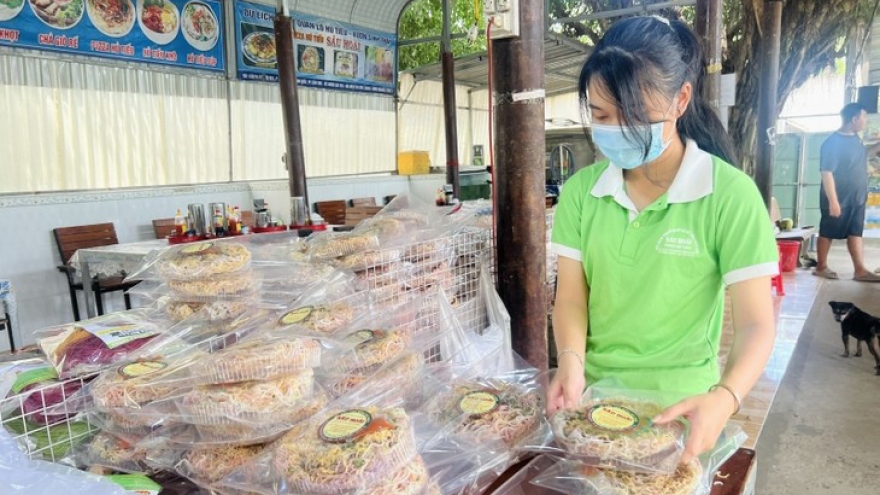Hong Kong newspaper highlights three Vietnamese noodle dishes
VOV.VN - Hong Kong media outlet South China Morning Post (SCMP) has published an article advising international visitors not to miss out on three wonderful Vietnamese noodle dishes, including cao lau in Hoi An, bun ca in Hanoi, and Phu Quoc’s ‘stirring noodles’.

While noodle dishes such as pho, bun cha, and bun bo hue are must-eat dishes when visiting the country, the article pays tribute to lesser-known but equally thrilling bowls which are specific to certain towns and cities.
The noodle journey through the nation starts in Hanoi with bun ca, not to be confused with bun cha. Bun means “rice noodle” and ca is “fish”, although there is more to this stellar local favourite than that.
The publication outlines that like many Vietnamese soups, the deep and sophisticated bun ca broth is made by simmering pork bones for a long time. After this, all ingredients are added to the mix, including tomatoes, wine vinegar, and fresh dill. They impart light and fresh herbal notes and acidity to a dish, which in turn beautifully combines sweet and sour flavours.
Toppings for this delicacy can include crunchy fried catfish or bouncy fishcakes, along with mounds of fresh herbs such as coriander and basil.
The article goes on to state that Hoi An’s fantastic cao lau noodles tick all of the flavour boxes when it comes to Vietnamese cuisine as they’re sweet, sour, salty, spicy, and bitter.
At Quan Cao Lau Thanh, a restaurant located in the ancient town of Hoi An, visitors can be forgiven for thinking that their first bite of the thick noodles are actually Japanese udon. The similarity makes sense considering the city’s rich and vibrant history, the piece notes.
Back in the 17th century, Japanese silver traders were some of Hoi An’s most important merchant visitors and they brought their knowledge of noodles with them.
What helps make cao lau such a brilliant dish is the layering of all of the ingredients, including a soup base of slow-simmered pork bones with notes of star anise and cinnamon, five-spice pork soaked in soy sauce and fish sauce, a verdant tangle of basil, mint, and coriander, along with the crunch and freshness of bean sprouts.
Finally, the island of Phu Quoc off the country’s southwest coast is home to bun quay, or “stirring noodles”, with Kien Xay being one of the area’s most famous purveyors. It started out as a family soup house, but quickly grew in popularity. Today, Kien Xay is a chain of restaurants which has locations in Ho Chi Minh City and Hanoi.
Bun quay in Kien Xay allows patrons an interactive dining experience because every diner can prepare their own nuoc cham dipping sauce. This makes it a popular choice for families.
First, diners head to the counter under a hanging sign which directs readers in English to “make your sauce”. Here guests can mix together chilli, fish sauce, calamansi, salt, sugar, and MSG, balancing sweet, salty, umami, and sour as they see fit.
After this, patrons can then watch their rice flour noodles being made. Chefs take a piece of dough and then cut it directly into boiling water, before dividing the cooked noodles and broth between bowls and adding shrimp paste and a choice of proteins such as shrimp cakes, baby squid, or beef.
A huge fan of Kien Xay is Spanish-born Bruno Anon, the executive chef at the nearby Regent Phu Quoc hotel, whose love of noodles stems from residing for many years in Asia.
“The soft, chewy white rice noodles are perfect with the shrimp, fish paste and simple, clear, slightly sweet broth. The noodles and the seafood are so fresh that all they need to cook is a splash of hot, hearty broth poured over them in the bowl,” he says.
“However, really the dipping sauce makes this soup stand out and hits all the taste buds. [It’s] sweet, sour, salty, spicy, and umami,” Anon adds.
To Anon, noodles are not just a dish, but a tradition and a ritual, likening the cuisine to eating a paella dish in his hometown of Valencia. “It’s the whole experience,” he explains, “Sharing a bowl of noodles with others sharing stories, a way of life.”


